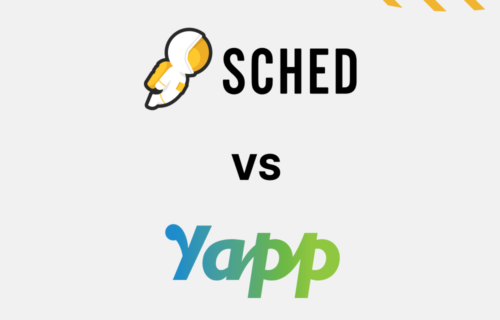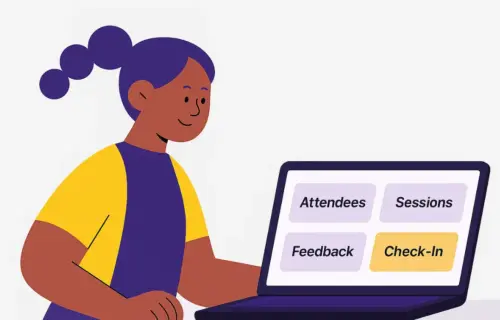Let’s face it… school events, whether large or small, are a huge challenge to manage. From coordinating schedules and managing speakers to tracking attendance and collecting feedback, the process requires time and precision. Manual planning methods make event management way more complicated than it needs to be.
Event management software gives educators the opportunity to run their events with increased access and ease for everyone: attendees, speakers, sponsors, and of course… planners! However, understanding the return on investment of such a tool—how much time, money, and effort it can actually save—is not always straightforward.
In this blog, you will learn how event management software can help schools save time, cut administrative costs, and maximize the impact of their events. Plus, we will break down a simple formula to calculate the ROI of event management software and show how school districts are using Sched to improve their event planning process.
The Biggest Hurdles In School Event Planning
Table of contents
- 1 The Biggest Hurdles In School Event Planning
- 2 How Event Management Software Can Help Schools Save Time and Money
- 2.1 1. Reduce Administrative Costs and Workload
- 2.2 2. Automate Key Event Planning Processes
- 2.3 3. Keep All Event Information In One Place
- 2.4 4. Improve Communication and Reduce Last Minute Confusion
- 2.5 5. Simplify Registration for a Better Attendee Experience
- 2.6 6. Optimize Room Assignments and Resource Allocation
- 2.7 7. Track Attendance and Engagement with Real-Time Data
- 2.8 8. Plan Future Events Faster and More Efficiently
- 3 How to Determine the ROI of Event Management Software for Schools
- 4 Why Schools Trust Sched To Turn Chaos Into Seamless Events
Tracking event attendance and coordinating speakers is a constant challenge. When it comes to event management, our work with thousands of K-12 schools coast to coast shows that many face the same hurdles over and over again.
These are some of the biggest challenges schools encounter when planning events:
1. Miscommunication Creates Confusion
Last-minute schedule changes and unclear event details can cause frustration among teachers and event planners. Poor communication can result in attendees missing important updates, attending the wrong sessions, arriving late, or feeling unprepared.
2. Low Educator Engagement
When school events like professional development (PD) sessions, continuing education programs, and teacher conferences feel impersonal or lack resources, educators struggle to stay engaged and gain real value from the experience. When events lack interactive elements and easily accessible materials, participation drops, reducing the event’s overall impact.
3. Room Planning Issues Lead to Overcrowding
If you are organizing a PD session or conference, for example, ensuring that each session has the right room size can be a challenge. Without a flexible system, some rooms may be too small, while others remain unused. Sudden demand can create last minute changes. This leads to overcrowded sessions, frustrated attendees, and last-minute logistical headaches for organizers.
4. Limited Event Planning Tools Create More Work
Schools often rely on Google Forms, spreadsheets, and other basic tools to organize events. However, these tools weren’t built for managing school events. Relying on multiple disconnected apps makes event management more complicated, especially for those who are juggling multiple responsibilities.
5. Tracking Attendance and Feedback Is Hard
Managing event attendance, measuring session popularity, and collecting feedback usually requires too much manual effort. Schools often rely on sign-in sheets or separate survey tools, which makes it difficult to track data accurately and in real time. Without an automated system, gathering insights takes extra time and increases the risk of errors or incomplete data.
6. Speaker Management Can Be Disorganized
Coordinating event speakers is not always a breeze. Booking speakers, collecting their bios and session materials, and keeping everything updated is time-consuming. A disorganized process can lead to delays and missing information.
How Event Management Software Can Help Schools Save Time and Money
Event management software helps schools create smoother, more organized events.
Sched, for example, allows you to manage event registration, attendee check-in, and analytics in one place. The platform is flexible enough to support events of any size, from small PD workshops to large-scale conferences.
These are some of the ways an event management tool like Sched can help you create a more seamless event experience:
1. Reduce Administrative Costs and Workload
Less time spent on manual event coordination means lower labor costs, fewer errors, and more time for higher-impact tasks. Schools can better allocate resources while reducing stress and burden.
2. Automate Key Event Planning Processes
Automating scheduling, speaker management, and attendance tracking removes repetitive tasks. It makes it easier to manage even the most complex school events. As a result, event planners get more time back to focus on delivering high-quality learning experiences.
3. Keep All Event Information In One Place
A centralized platform eliminates the need for scattered spreadsheets and disconnected tools. This keeps event planning more organized, efficient, and stress-free.
4. Improve Communication and Reduce Last Minute Confusion
Automated notifications and real-time updates keep attendees, speakers, and event staff informed at all times. Situations such as last-minute schedule changes are easier to manage.
5. Simplify Registration for a Better Attendee Experience
A smooth registration process allows attendees to check-in, stay updated on event details, and access their schedules, all within the platform. Event organizers can easily track registration and monitor attendance. Attendees can pre-plan their own schedule easily and check-in with a QR code on arrival.
6. Optimize Room Assignments and Resource Allocation
Overcrowding and scheduling conflicts can easily be prevented with real-time data. You can assign the right rooms and resources to each session.
7. Track Attendance and Engagement with Real-Time Data
Obtain real-time insights into session popularity, attendee participation, and feedback. All this information can also help you improve future events.
8. Plan Future Events Faster and More Efficiently
With automated reporting and saved templates, you can reuse event structures and streamline the planning process year after year.
How to Determine the ROI of Event Management Software for Schools
Key Metrics to Measure ROI
To determine whether event management software is delivering value, K-12 schools should track:
- Attendance Tracking: Tracks the percentage of registered attendees who check in to measure participation and session effectiveness.
- Event Engagement Rate: Evaluates how educators interact with speakers and other attendees during sessions.
- Total Registrations vs. Show-Up Rate: Compares the number of registered attendees to actual participants to assess registration efficiency.
- Event Visibility & Reach: Helps you measure how well the event is promoted based on website visits, email opens, and social media engagement.
- Feedback Submission & Collection Rate: Shows you how many attendees provide post-event feedback to determine satisfaction levels and identify areas for improvement.
- Session Popularity & Capacity Utilization: Determines which sessions attract the most attendees. It helps you optimize scheduling and room assignments.
- Administrative Time & Cost Savings: Calculates reductions in manual tasks to show you how event management software improves efficiency and lowers costs.
K-12 schools can use this formula to calculate the return on investment of event management software:
ROI = [(Time Saved + Cost Savings + Increased Engagement Value) – Software Cost] / Software Cost
For example, let’s say:
- Your school reduces administrative labor hours spent on event planning and tracking attendance.
- You cut costs on printed materials, third-party registration tools, and manual check-in processes.
- Educator participation and session engagement increase, which leads to better training outcomes and knowledge retention.
When you calculate the total time and cost savings and compare it to the investment in event management software, you can determine whether the platform is providing a positive return.
Why Schools Trust Sched To Turn Chaos Into Seamless Events
Schools across the country trust Sched to simplify event planning and make sure their teachers get access to professional development that improves teaching skills and retains teachers. The platform helps you speed up event registration, track session popularity, easily collect post-event feedback, and centralize all event details in one place. As a result, you reduce administrative costs, save your staff hours on planning, and increase engagement at your events. This leads to a stronger ROI.
Pender County Schools used Sched to coordinate professional development across 19 schools and over 1,000 staff members. They significantly reduced time spent in manual work by automating event scheduling, conflict detection, and attendance tracking.
“I love the ability to filter by type of PD, see what’s available, and look at the calendar. It makes everything simple,” said Craig Lawson, Director of Digital Learning and Media at Pender County Schools.
Turn your school’s event chaos into a seamless experience. Start using Sched for free today.









